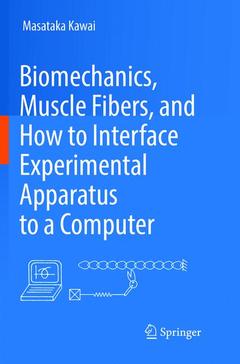Description
Biomechanics, Muscle Fibers, and How to Interface Experimental Apparatus to a Computer, 1st ed. 2018
Author: Kawai Masataka
Language: English
Subjects for Biomechanics, Muscle Fibers, and How to Interface...:
Approximative price 105.49 €
In Print (Delivery period: 15 days).
Add to cart
Biomechanics, Muscle Fibers, and How to Interface Experimental Apparatus to a Computer
Publication date: 06-2019
120 p. · 15.5x23.5 cm · Paperback
Publication date: 06-2019
120 p. · 15.5x23.5 cm · Paperback
Biomechanics, Muscle Fibers, and How to Interface Experimental Apparatus to a Computer
Publication date: 02-2018
Support: Print on demand
Publication date: 02-2018
Support: Print on demand
Description
/li>Contents
/li>Biography
/li>Comment
/li>
This book is written to help and enable students in how to observe biological specimens in terms of viscosity, mass, elasticity and work producing elements. The observations are related to underlying chemical reactions by means of strain (fractional length change) sensitivity of the reactions, and a theory is developed how to connect these. Their mathematical derivation is complex when three or more states are involved, but a method is presented here to demonstrate how to simplify this complex problem. Basic mathematical solutions that are useful for this book, are presented (Fourier and Laplace transforms, differential equations, matrix operations) together with Fortran programs in the Appendix.
Basic elements of viscoelasticity.- Reaction processes (chemical kinetics) and their application to muscle biology.- How to characterize chemical reactions occurring in muscle fibers?.- Structure and function of muscle cells.- Mathematics needed to solve problems of contraction.- Computer interfacing of experimental apparatus.- Appendices.
Dr. Masataka Kawai (spelled 河合正隆in Japanese) received his B.A. from The University of Tokyo (Pure and Applied Sciences 東京大学教養学部基礎科学科), Ph.D. from Princeton University (Biology; Princeton, NJ, USA), attended Physiology Course at Marine Biological Laboratory (Woods Hole, MA, USA), and postdoctoral training at Colum-bia University (Muscle biology; New York City, USA), where he became a junior faculty member. He is now a professor of Anatomy and Cell Biology at The University of Iowa, College of Medicine, Iowa City, IA, USA. He has taught histology to medical and dental students for 35 years; he also taught principles of scholarly integrity to graduate and post-doctoral students. He has recently learned gross anatomy and teaches this subject. His hobbies include playing the piano, singing Japanese and Western lyrics, gardening, and travels.
A step-by-step guide to aid the understanding of biomechanics Comprehensive account relating chemical reactions to observed parameters A comprehensive section of the basic mathematical solutions
© 2024 LAVOISIER S.A.S.

